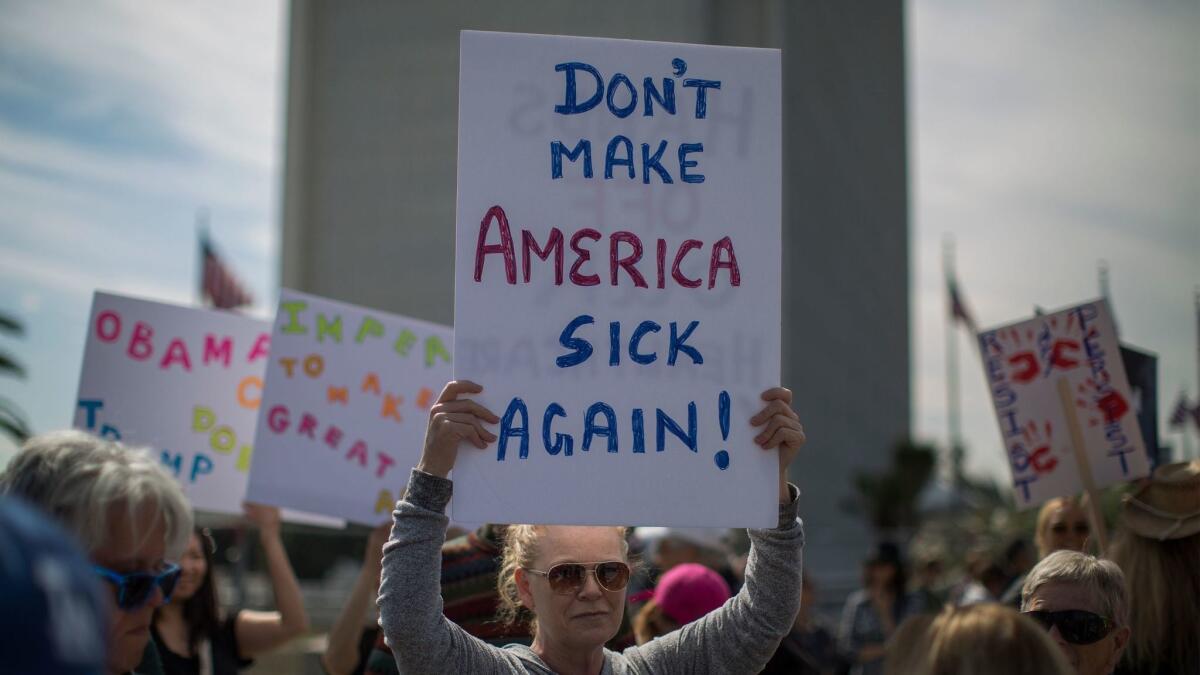Column: Contrary to conservative crabbing, a new study shows Medicaid expansion is really valuable

A newly published study of the Medicaid expansion in California says that the program substantially reduced in-hospital mortality for patients who gained coverage, put hospitals on a firmer financial footing, and improved access to care, and better care, for millions of residents.
Yet Robert VerBruggen of National Review thinks the study shows that “we have a system that makes it entirely rational to dump tons of money into a healthcare program that doesn’t improve health very much.” (H/t Kevin Drum, who unearthed the VerBruggen article.)
Something must be off here, and the answer may be that VerBruggen didn’t pay much attention to what the paper’s authors, led by Stanford economist Mark G. Duggan, actually said about what they learned.
The expansion led to substantially greater hospital and emergency room use, and a reallocation of care...to private and better-quality hospitals.
— Duggan, et. al.
The study shined a spotlight on the results of California’s determined embrace of the Affordable Care Act, which paid for the expansion of Medicaid (known as Medi-Cal in California) in those states that chose to do so. Medicaid enrollment in California increased to more than 13 million from 8 million, while Medicaid spending rose to $100 billion a year from $40 billion. Virtually all the increase has been covered by the federal government.
The paper confirms that much of what the Medicaid expansion’s designers hoped to achieve has come to pass. Chiefly, their goals were to improve the economics of hospitals and improve access to care for America’s poorest residents.
Indeed, Duggan told me, hospitals in California experienced huge economic gains while making people on Medicaid “less vulnerable to economic shocks” from medical problems. “If you’re living paycheck to paycheck and you get a severe medical event, it can ruin you financially. Whereas if you have health insurance that’s much less true.”
Before the Affordable Care Act, there were sharp disparities in insurance coverage between 64- and 65-year-olds and also between 20- and 21-year olds, the authors report.
That’s because Medicaid or other government programs were available to those over 65 and younger than 21, but not to most people in between. The ACA, chiefly Medicaid expansion, “nearly eliminated the disparity” at both points, the paper found. Newly enrolled patients have tended to drift toward privately owned and better-quality hospitals for their care.
Hospital finances sharply improved for both public and private institutions. The average government hospital received an increase in revenue per bed of nearly 20%, and private hospitals gained 8%. In part, this was because the federal program took over funding from county-level programs, which paid hospitals less and were financially strapped anyway. In other words, money flowed from federal taxpayers to local taxpayers.
An obvious conclusion stems from that: The 14 states that have not yet accepted Medicaid expansion, which now will be 90% covered by the federal government, are run by idiots. They’re turning up their noses at federal funding and sticking their local taxpayers for the bill (if their hospitals are providing decent care) or lousy care (if they’re not). Their taxpayers, moreover, are sending their money to expansion states and getting nothing in return.
But what about patient health? The study found that hospital “inpatient mortality has declined meaningfully post-ACA.” The study looked at mortality for patients with heart conditions and pneumonia, which can’t be treated outside a hospital. The actual mortality decline, the authors say, was about 7% of the mean mortality rate, which is insignificant statistically, but “substantial,” Duggan says.
The reason that a change can be substantial but not statistically significant is chiefly an artifact of statistical math — there simply aren’t enough 64-year-olds for their numbers to have sufficient statistical power.
Studies like Duggan’s have some other limitations. One is that the paper covered only three years of post-ACA experience, and the health effects of improved insurance are likely to appear over a longer time span. Also, the paper relied on hospital inpatient figures, so non-hospital outcomes aren’t measured but may be significant.
Finally, patients can experience health improvements at many levels. “A lot of the ways health could improve wouldn’t be captured by mortality alone,” Duggan says. Health insurance, for instance, “can reduce the amount of pain they’re in or reduce the severity of a condition they have, but that may not show up in mortality.”
At National Review, VerBruggen doesn’t let any such niceties stop him from making broad pronouncements. Sure, hospitals and local budgets did well, he acknowledged, “but gains to actual health are harder to find.” But it seems he just jumped the gun.
VerBruggen comes off as another conservative with the knives out for Medicaid, our one public health program specifically aimed at low-income people. He tips his hand by citing the notorious Oregon health study of 2010, which conservatives have misinterpreted for nearly a decade to suggest that Medicaid is worthless.
They focus on the study’s general conclusions that it found “no significant effect … on the prevalence or diagnosis of hypertension or high cholesterol levels or on the use of medication for these conditions” and that although Medicaid improved the diagnosis of diabetes, it found “no significant effect” on diabetes markers in the bloodstream.” VerBruggen joins the conservative chorus declaring that this proves it’s a struggle “to find health improvements from Medicaid.”
That’s not what the Oregon study found, however. It noted that Medicaid coverage reduced the rate of depression diagnoses for Medicaid patients, raised the percentage of people reporting improved health over a year earlier, “increased the use of many preventive services, and nearly eliminated catastrophic out-of-pocket medical expenditures.” The study also noted that it was limited to the first two years of expanded Medicaid, not long enough to judge long-term impacts.
Obviously, lower levels of depression, higher rates of diabetes diagnoses, more preventive care and lower catastrophic health spending are good things. It’s always hard to figure out what the anti-Medicaid gang wishes to see. Drum, at Mother Jones, suggests that the problem is that studies like the Stanford paper “define ‘health’ as ‘not dying.”
That may be because it’s hard to put one’s finger on health benefits that fall short of that clear inflection point, but he’s right that it’s a mistake to think that getting a cavity filled or obtaining an antidepressant prescription or getting a new hip “doesn’t count.”
All the evidence points to the conclusion that Medicaid expansion improves the economics of healthcare for patients and providers alike and access to care in ways likely to translate into measurable gains in health over time.
Keep up to date with Michael Hiltzik. Follow @hiltzikm on Twitter, see his Facebook page, or email [email protected].
Return to Michael Hiltzik’s blog.







